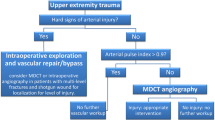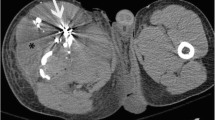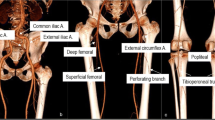Abstract
Multi-detector computed tomography angiography (MDCTA) of the lower extremities is an integral part of the decision-making process of lower extremity trauma. MDCTA can be integrated into multiphasic whole-body trauma MDCT and has replaced the traditional gold standard of catheter-based angiography as the preferred technique for the initial assessment of lower extremity trauma in many institutions worldwide. Advances in MDCT technology enable high speed simultaneous evaluation of both complete lower extremities, rapid image reconstruction, and advanced image visualization for the noninvasive and accurate diagnosis of vascular, including hematoma, active extravasation, vasospasm, stenosis, external compression, occlusion, intimal injury and dissection, arteriovenous fistulas, and pseudoaneurysm formation. In this exhibit, we outline the role of MDCTA in the management of lower extremity trauma, review current MDCT protocols and the practical use of advanced visualization techniques, and illustrate typical MDCTA findings, pearls, and pitfalls, which help to accurately characterize vascular injury and guide management.


















Similar content being viewed by others
References
Novelline RA, Rhea JT, Rao PM, Stuk JL (1999) Helical CT in emergency radiology. Radiology 213:321–339
Rivas LA, Fishman JE, Munera F, Bajayo DE (2003) Multislice CT in thoracic trauma. Radiol Clin North Am 41:599–616
Geijer M, El-Khoury GY (2006) MDCT in the evaluation of skeletal trauma: principles, protocols, and clinical applications. Emerg Radiol 13:7–18
Kalra N, Khandelwal N, Gupta P et al (2008) MDCT arteriographic spectrum in acute blunt peripheral trauma—a pictorial review. Emerg Radiol 15:91–97
Murakami AM, Anderson SW, Soto JA, Kertesz JL, Ozonoff A, Rhea JT (2009) Active extravasation of the abdomen and pelvis in trauma using 64MDCT. Emerg Radiol 16:375–382
Uyeda J, Anderson SW, Kertesz J, Soto JA (2010) Pelvic CT angiography: application to blunt trauma using 64MDCT. Emerg Radiol 17:131–137
Schroeder JW, Baskaran V, Aygun N (2010) Imaging of traumatic arterial injuries in the neck with an emphasis on CTA. Emerg Radiol 17:109–122
Shah N, Anderson SW, Vu M, Pieroni S, Rhea JT, Soto JA (2009) Extremity CT angiography: application to trauma using 64-MDCT. Emerg Radiol 16:425–432
Foster BR, Anderson SW, Uyeda JW, Brooks JG, Soto JA (2011) Integration of 64-detector lower extremity CT angiography into whole-body trauma imaging: feasibility and early experience. Radiology 261:787–795
Iezzi R, Cotroneo AR, Pascali D, Merlino B, Storto ML (2007) Multi-slice CT (MSCT) angiography for assessment of traumatic lesions of lower limbs peripheral arteries. Emerg Radiol 14:389–394
Chen JK, Johnson PT, Fishman EK (2006) Femoral artery occlusion after blunt trauma: diagnosis by multislice CT angiography. Emerg Radiol 12:244–245
Dennis JW, Frykberg ER, Veldenz HC, Huffman S, Menawat SS (1998) Validation of nonoperative management of occult vascular injuries and accuracy of physical examination alone in penetrating extremity trauma: 5- to 10-year follow-up. J Trauma 44:243–252
Soto JA, Munera F, Cardoso N, Guarin O, Medina S (1999) Diagnostic performance of helical CT angiography in trauma to large arteries of the extremities. J Comput Assist Tomogr 23:188–196
Busquets AR, Acosta JA, Colon E, Alejandro KV, Rodriguez P (2004) Helical computed tomographic angiography for the diagnosis of traumatic arterial injuries of the extremities. J Trauma 56:625–628
Uflacker R, Elliott BM (1996) Percutaneous endoluminal stent-graft repair of an old traumatic femoral arteriovenous fistula. Cardiovasc Intervent Radiol 19:120–122
Dorros G, Joseph G (1995) Closure of a popliteal arteriovenous fistula using an autologous vein-covered Palmaz stent. J Endovasc Surg 2:177–181
Sclafani SJ, Cooper R, Shaftan GW, Goldstein AS, Glanz S, Gordon DH (1986) Arterial trauma: diagnostic and therapeutic angiography. Radiology 161:165–172
Rose SC, Moore EE (1987) Angiography in patients with arterial trauma: correlation between angiographic abnormalities, operative findings, and clinical outcome. AJR Am J Roentgenol 149:613–619
AbuRahma AF, Robinson PA, Boland JP et al (1993) Complications of arteriography in a recent series of 707 cases: factors affecting outcome. Ann Vasc Surg 7:122–129
Inaba K, Potzman J, Munera F et al (2006) Multi-slice CT angiography for arterial evaluation in the injured lower extremity. J Trauma 60:502–506
Frykberg ER (1995) Advances in the diagnosis and treatment of extremity vascular trauma. Surg Clin North Am 75:207–223
Frykberg ER, Dennis JW, Bishop K, Laneve L, Alexander RH (1991) The reliability of physical examination in the evaluation of penetrating extremity trauma for vascular injury: results at one year. J Trauma 31:502–511
Namasivayam S, Kalra MK, Torres WE, Small WC (2006) Adverse reactions to intravenous iodinated contrast media: a primer for radiologists. Emerg Radiol 12:210–215
Anderson SW, Lucey BC, Rhea JT, Soto JA (2007) 64 MDCT in multiple trauma patients: imaging manifestations and clinical implications of active extravasation. Emerg Radiol 14:151–159
Lee MJ, Kim S, Lee SA et al (2007) Overcoming artifacts from metallic orthopedic implants at high-field-strength MR imaging and multi-detector CT. Radiographics 27:791–803
Gunn ML, Kohr JR (2010) State of the art: technologies for computed tomography dose reduction. Emerg Radiol 17:209–218
Kalra MK, Rizzo SM, Novelline RA (2005) Reducing radiation dose in emergency computed tomography with automatic exposure control techniques. Emerg Radiol 11:267–274
Kalra MK, Rizzo SM, Novelline RA (2005) Technologic innovations in computer tomography dose reduction: implications in emergency settings. Emerg Radiol 11:127–128
Huda W (2009) What ER radiologists need to know about radiation risks. Emerg Radiol 16:335–341
Nakaya Y, Kim T, Hori M et al (2009) 64-slice multidetector row computed tomographic angiography of aortoiliac and lower extremity arteries: efficacy of test injection using a monitoring scan at knee level. J Comput Assist Tomogr 33:20–25
Conflict of interest
The authors declare that they have no conflict of interest.
Author information
Authors and Affiliations
Corresponding author
Rights and permissions
About this article
Cite this article
Fritz, J., Efron, D.T. & Fishman, E.K. State-of-the-art 3DCT angiography assessment of lower extremity trauma: typical findings, pearls, and pitfalls. Emerg Radiol 20, 175–184 (2013). https://doi.org/10.1007/s10140-012-1094-4
Received:
Accepted:
Published:
Issue Date:
DOI: https://doi.org/10.1007/s10140-012-1094-4




